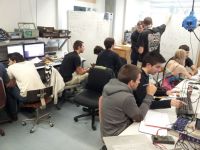Build-your-own Brain-Computer Interface

ETH D-ITET P&S Module Overview
Description: This module instructs students on the basics of building their own EEG setup to record real-time brain signals externally from the surface of their own scalp. The module will work through amplifier design, real-world filter design, signal processing, and data visualization. The module is strongly project-based, with two main phases. In the first phase, students build a multi-stage amplifier and filter setup to capture the EEG signals, convert the signals from analog to digital, and then process and visualize the signals in software on a host computer. At the end of this first phase, students can control a Pong paddle with their alpha waves. In the second half of their module, students divide up into teams of 2 or 3 to tackle a problem of their choosing, with examples given from biofeedback, eye tracking, deep learning, remote robotic control, and health monitoring.
Open to 3rd year students and above, up to a maximum of 12 students
Time: 3 hours per week
Instructor: Dr. Shih-Chii Liu
Language of Instruction: English
Prerequisites: Basic electronics and programming
TA: Danny Neil
Additional TAs: Enea Ceolini, Ilya Kiselev
Available Projects
Ready-to-go projects, with components and software:
- Advanced classifiers: using modern models from machine learning such as deep recurrent neural networks to build better and faster classifiers for EEG data.
- Multi-electrode setup: using multiple Arduinos and amplifiers, design a 16-channel EEG.
- Games: use the EEG to control an agent in a game like Pong.
Alternate Projects, to inspire further creativity:
- Improved filter design: employ filter design skills to build an optimized pre-amplifier that performs more cleaning of the signal before its conversion to digital.
- Easily-wearable design: determine how to use dry electrodes and local amplifiers to install in a headband for a consumer wearable device.
- Biofeedback: using EEG and EKG signals, design a system by which a user can train involuntary processes such as heart rate or alpha wave generation, or to mitigate issues like headaches.
- Sleep study: develop an application that monitors the subject while sleeping to monitor sleep quality.
- Eye tracking: using the EEG setup as an EMG, locate the gaze of the eye on a computer screen.
- Silent communication: using classifiers and training both the user and a software model, transmit a small vocabulary of words to a recipient, silently.
- Art: use the EEG to create interactive art.
- Mechanical Feedback: see effect of mechanical tapping on EEG signal
Schedule
Session: Thursday 1-4 pm
Starting date: Mar 24th (Thursday)
Place: Institute of Neuroinformatics, Dungeon Lab, Y35 E 30, Uni Zurich Irchel Campus
Module ends: Jun 2
Lectures/Labs
- Mar 24 - Exploring characteristics of filters needed for EEG experiments. Construction of circuit for amplification of signals from EEG electrodes, construction of filters for extracting signals <40Hz and rejecting line frequencies.
- Mar 31 (holiday)
- Apr 7 Software for signal acquisition and frequency analysis on EEG signals.
- Apr 14 Demo of setup with EEG electrodes, preamplifier, and signal acquisition.
- Apr 21 Basic machine learning lecture. Exercise on simple classifiers.
- Apr 28 EEG lecture. Project Construction/Recording/Experimentation
- May 5 Project Construction/Recording/Experimentation
- May 12 Project Construction/Recording/Experimentation
- May 19 Project Construction/Recording/Experimentation
- May 26 Project Writeup
- Jun 2 (All available) - Project Presentation
